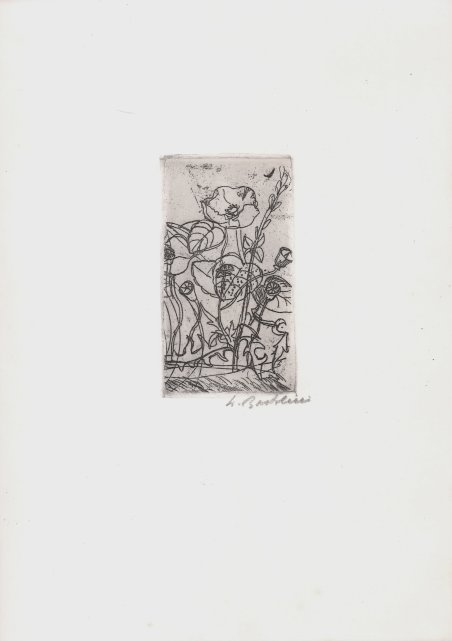Acquaforte, 1954, firmata a matita in basso a destra. Si tratta di una delle 7 acqueforti che illustrano il libro di Luigi Bartolini, LA CACCIA AL FAGIANO – una cartella di acqueforti stampata da Editore Vallecchi, Firenze 1954 (il volume uscì invece fra l'ottobre e novembre del 1955). Esistono due edizioni: una limitata a 200 esemplari firmati dall'autore e numerati da 1 a 200 che contengono, fuori testo, firmate ma non numerate, sette acqueforti originali. La seconda edizione, tirata in 800 esemplari numerati e firmati dall'autore, contiene, in originale, solo l'incisione del Nobile fagiano, le altre sono riprodotte. Le incisioni furono stampate, con fondino Oxford, da Michele Gnocchi con l'aiuto dello stesso Bartolini presso la Calcografia Nazionale di Roma. Nel volume sono pubblicati due racconti, La caccia al fagiano e Un altro fagiano più una poesia, Parcines. Curioso constatare che nonostante questa stessa poesia sia stata pubblicata, sotto il titolo Il fagiano di Parcines, in “Poesie 1954” e in "Mal'aria" n. 8 del giugno 1954 è qui notevolmente modificata. Luigi Bartolini è considerato uno dei maggiori incisori italiani del Novecento, insieme a Giorgio Morandi e Giuseppe Viviani. Oltre ad essere un prolifico incisore (al suo attivo oltre mille acqueforti), fu anche pittore e scrittore. Partecipò sia come pittore che come incisore a diverse edizioni della Biennale di Venezia dal 1928 al 1962. Presente a varie manifestazioni artistiche, sviluppò diverse maniere definite: ‘maniera bionda’, ‘lineare’ e ‘nera’. Ricordiamo soprattutto le acqueforti della serie Marche e della serie Sicilia. ' ' Iniziò la sua produzione grafica nel 1914 e il suo stile si rifà alla tradizione naturalistica dell’Ottocento. Molte sue incisioni si possono ricollegare ad alcune opere del Goya, di Telemaco Signorini e di Giovanni Fattori. Eccellente nella rappresentazione della natura morta e del paesaggio, spesso il Bartolini rappresentò dolcemente le cose e gli oggetti più umili, i soggetti di natura più dimessi. In essi ritroviamo il sentimento che diviene immagine e la forma che si sviluppa in espressione. Con Bartolini l’incisione torna ad essere un mezzo di espressione poetica libera dal simbolismo e dal vedutismo allora in voga presso le accademie. Nelle sue acqueforti prevale ora un tratteggio leggero (genere biondo), ora una ricerca del chiaroscuro alla Rembrandt (genere nero). Magnifica prova, con margini, in ottime condizioni. Etching, 1954, signed in pencil at lower right. This is one of the 7 etchings illustrating Luigi Bartolini's book, LA CACCIA AL FAGIANO - a portfolio of etchings printed by Editore Vallecchi, Florence 1954 (the volume came out instead between October and November 1955). Two editions exist: one limited to 200 examples signed by the author and numbered from 1 to 200 containing, out of text, signed but not numbered, seven original etchings. The second edition, printed in 800 examples numbered and signed by the author, contains, in the original, only the etching of the Nobile Fagiano (Noble Pheasant); the others are reproduced. The engravings were printed, with Oxford backing, by Michele Gnocchi with the help of Bartolini himself at the Calcografia Nazionale in Rome. Luigi Bartolini is considered one of the greatest Italian engravers of the twentieth century, along with Giorgio Morandi and Giuseppe Viviani. Besides being a prolific engraver (over a thousand etchings to his credit), he was also a painter and writer. He participated both as a painter and as an engraver in several editions of the Venice Biennale from 1928 to 1962. Present at various artistic events, he developed several mannerisms defined as: 'blond manner,' 'linear manner,' and 'black manner.' We especially remember the etchings of the Marche series and the Sicily series. He began his graphic production in 1914, and his style draws on the naturalistic tradition of the 19th century. Many of his etchings can be related to some of the works of Goya, Telemaco Signorini, and Giovanni Fattori. Excellent in the depiction of still life and landscape, Bartolini often softly represented the humblest things and objects, the most humble subjects of nature. In them we find sentiment becoming image and form developing into expression. With Bartolini, etching once again became a means of poetic expression free from the symbolism and vedutism then in vogue in the academies. In his etchings a light hatching prevails now (blond genre), now a Rembrandt-like search for chiaroscuro (black genre). Magnificent proof, with margins, in very good condition. Cfr.

Find out how to use
Find out how to use

